Woodburning for Beginners:
FAQs, Terms & Answers to Your Burning Questions
Got some questions about woodburning for beginners? Maybe like... What is pyrography? How do you shade? Is this called a tip, point, or nib?
Hey newbie!
When I was in your shoes, I would read things in books and forums like "live edge" or "nibs"... and mostly just sat there with a big question mark on my forehead.
I had ZERO idea what they were talking about.
Let's spare YOU that confusion, shall we?
Here are some pyrography definitions, terms and common questions in the woodburning community and professional pyrography industry.
These will help you sound like you know more of what you're doing. ;)
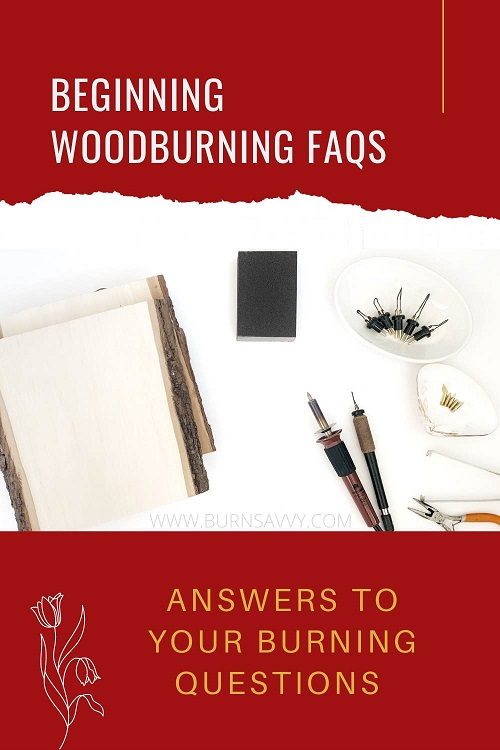
Want To Learn How To Wood Burn?
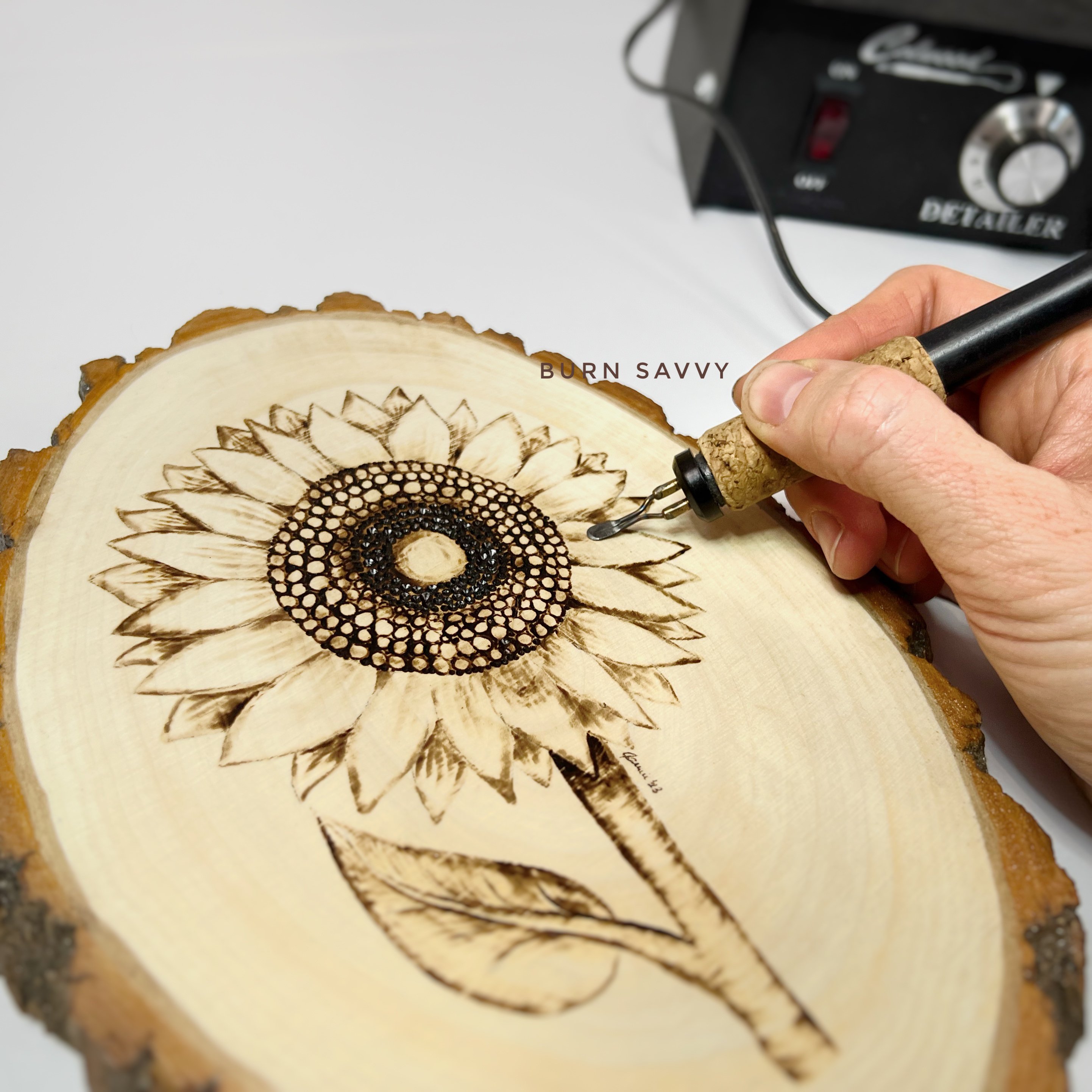
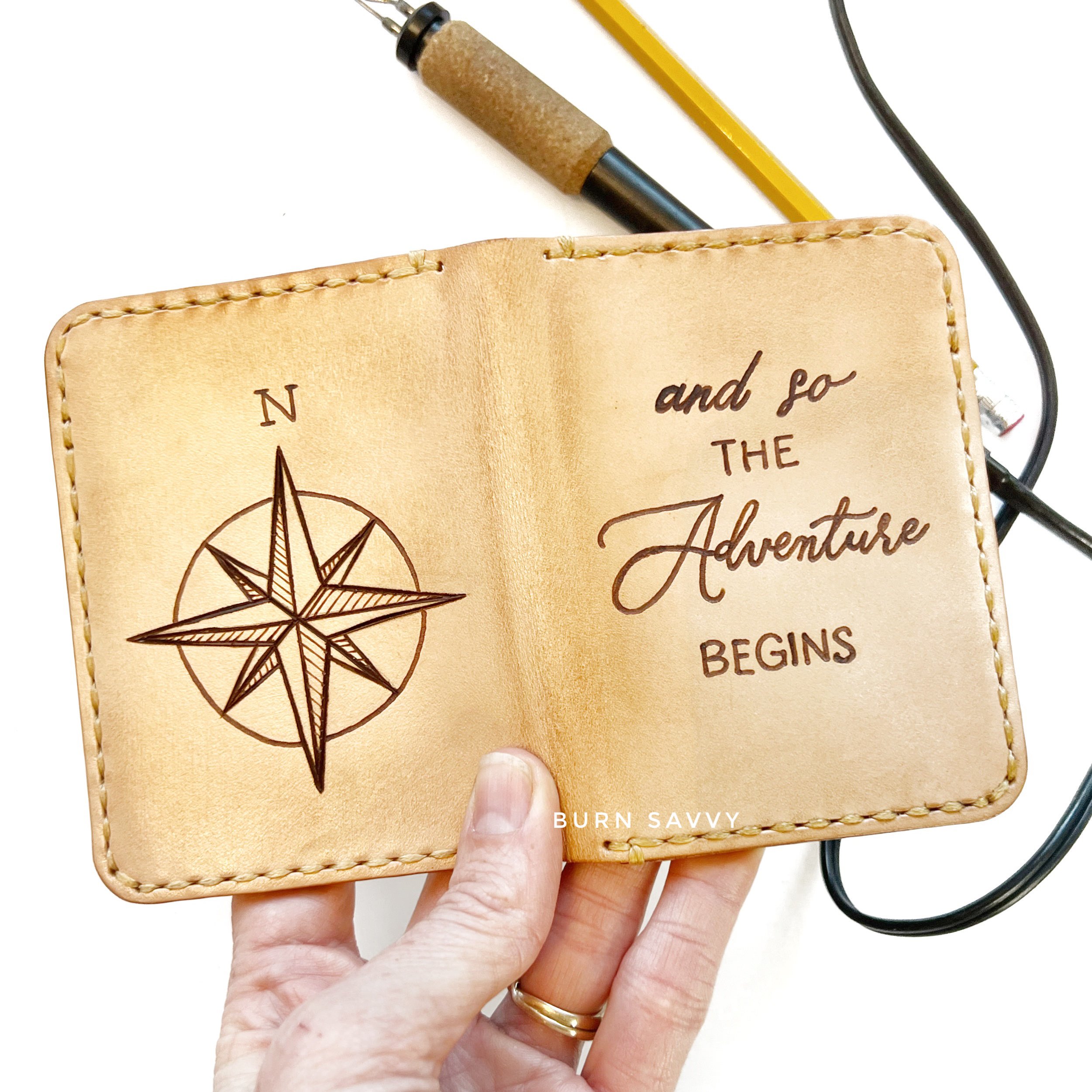

Courses are now available on the Burn Savvy YouTube channel membership!
Go see which level suits YOU best. ⇣
Woodburning for Beginners: General Terms
What is Pyrography?
Is it woodburning? Writing with fire? Fire art?
Simply put, pyrography is the art of burning a design on something.
I go into detail on that in this article called What is Pyrography? Definitions, History + More.
Do you call it "Wood Burning", "Woodburning" or "Wood-Burning"
Generally, “wood burning” with a space between the 2 words refers to wood burning stoves, throwing logs in the fireplace, burning old branches that were pruned off trees… that sort of thing.
“Woodburning” written as one single word refers to the art of burning wood, or pyrography.
Hyphenated “wood-burning” goes either way.
When you’re on the forums and talking to the pros, you’ll mostly see them use the terms “woodburning” (no space, no hyphens) or “pyrography”.
Here on Burn Savvy you’ll see “woodburning” typed both with and without a space because I’m trying to get answers to people who search for both terms.
What is a Woodburner?
Depends.
Are you referring to the person doing the woodburning? Or the tool they are using?
You can call the artist or the tool a “woodburner” and still be right.
The Person Burning
If it’s the person burning, they’re basically just called an “artist”. But there is nothing wrong with calling them a "burner" too.
The Hot Tool Doing the Burning
If it’s the tool you are talking about, you will hear all kinds of things under the sun – machine, tool, burner – all of which are correct.
If it’s a solid point tool (don’t know what that is? Keep scrolling down and you’ll find that definition) it will also be called a soldering tool because… well, that’s what it is!
If it’s a wire nib tool (again, definition below) it is often called a pyrography “pen”. Although technically, the pen is only part of the tool.
Woodburning for Beginners:
Tool Questions
Solid Point vs Wire Nib - Woodburning Machines
There are basically 2 kinds of woodburning machines (check out the pictures in the burner anatomy section below).
Solid Point machines are soldering irons. Some of them are *glorified* soldering irons – with heat control and a handful of nib options. They get their name from the “solid” nibs that they use.
Wire Nib machines act more like hot pens. The wires are specialized for art, get a precise burn more easily, and tend to have more control over the heat.
Don’t get me wrong. You can absolutely get a precise burn with a solid point machine…
…but it will go SOOOO much faster with a wire nib burner!
You can read more about both burners in this pretty little article right here.
Tips, Points, or Nibs? Which is the right term?
These terms refer to the metal parts that actually touch the wood to draw the burn. And there are a lot of different kinds – depending on which brand you bought.
Different companies use different terms too. Walnut Hollow calls these “points”. Razortip, Colwood, and PJL Enterprises call these “tips”.
But you’ll hear a lot of professionals call them nibs.
Which is correct? All of them.
But frankly, the term “nibs” is less confusing. And here’s why…
Take this sentence for example… “Here are some woodburning tips!”… sooooo are you giving me advice or accessories for my machine?
Same confusion happens with woodburning “points".
On a calligraphy pen, ink comes out of a “nib”. On a woodburning tool, the part that actually makes the mark is also a “nib”.
So “nib” is my favorite of the 3. Even though none of these terms are “wrong”, the term “nibs” is much more clear.
Don’t you think?
But you’ll see me use the less clear term “tips” on this website because that’s what people are searching for (and in all fairness, they don’t know what else to call them).
If you want to deep dive into woodburning tips and their uses, I’ve got a must-see article for you right here. This is for solid point nibs.
The wire nib series will be coming sometime in 2021 (email subscribers will be the first to know when!).
Machine Anatomy:
What is THAT part called?
Machine anatomy can be a confusing aspect of woodburning for beginners since different companies use different terms. But I used several manuals and guides on woodburning for beginners from manufacturers and adapted them to put this together for you.
In other words, use this as a general guideline.
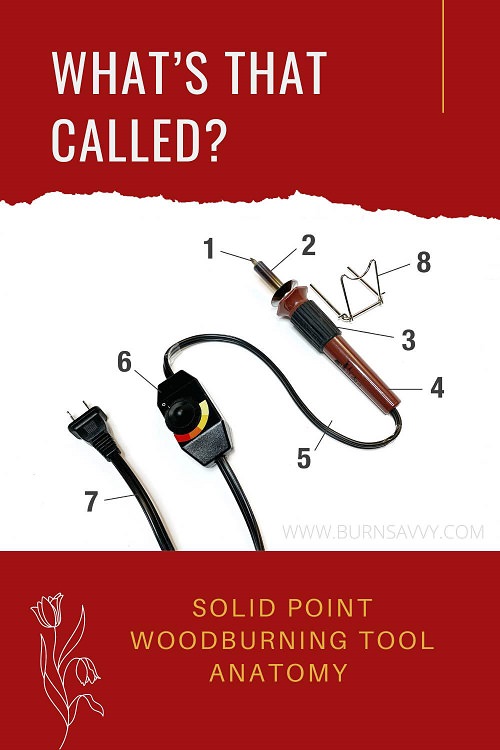 |
Solid Point Woodburning Machine
|
|
|
|
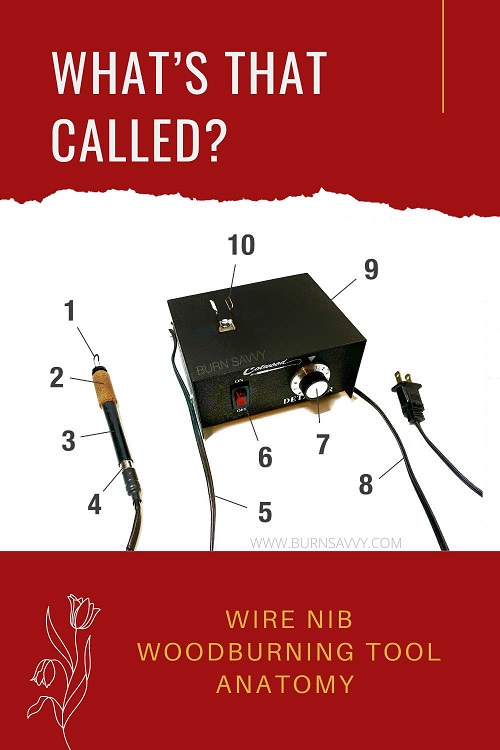 |
Wire Nib Woodburning Machine
|
I would be remiss if I didn't add tools to this page of woodburning for beginners. For other awesome woodburning tools aside from the burner itself, check out my list of the best woodburning tools.
Woodburning For Beginners:
Questions about Wood
Slabs vs Slices/Cookies/Rounds
These are referring to cuts of wood.
A slab tends to run with the grain instead of against it. Imagine cutting a log like you are peeling a carrot in thick slices or making your own carrot sticks. You will see grain in a slab, but will be less rough because it is cutting WITH the grain.
Slices, cookies, and rounds all refer to the same kind of cut – a cut across or against the grain of the wood. Imagine cutting down a tree trunk, then slicing it up like you’re chopping a carrot in small discs. Think coins. Slices are cut AGAINST the grain, showing every tree ring – which means you’re working with the roughest grain the wood has to offer.
Slices are harder to burn than slabs because the cut goes AGAINST the grain instead of WITH it. Keep that in mind when you are wood shopping.
Most processed woods – like cutting boards, spoons, tables, furniture, etc. – are made from slabs of wood (often glued together and cut to size) not slices.
Live Edge
Live edge wood is any wood that still has the bark on the edge. Most wood slices or wood cookies still have the bark around the edges, so they are live edge. You can also buy slabs of wood that still have 1 or 2 uncut sides – live edge sides – with the bark intact.
What Temperature does Wood Burn?
That depends on the wood.
Soft woods will burn at a lower heat while hard woods need higher heat.
What about wood burning on painted wood?
Don’t.
You’re burning paint. Ever tried that? (yuck!)
If the wood has been treated or painted with anything, it will put off toxic fumes as the chemicals burn. Some artists choose to do it anyway, and they often report headaches or feeling sick after. Doing that for a long time would definitely have long term effects on your body.
If you were to do it safely, you would need massive ventilation, a mask that protects from particles AND fumes, and who knows what else.
No thanks.
Learn more about what woods NOT to burn here.
Woodburning Technique Questions
How to Start Woodburning For Beginners?
It's coming!
I’m currently working on a course with all the essentials – what to look for when buying a burner, what wood to use, how to add color and finishes, all that good stuff.
This course is the essentials of woodburning for beginners and pros alike! (I've discovered a lot of pros don't even know some of the basics of finding wood, adding finishes, all that!)
Soon I will add another entry level course dedicated to mastering the pyrography techniques that are perfect to learn woodburning for beginners.
Burn Savvy Academy is under way!
My
email subscribers will be the first to know when that course goes live
(plus extra perks and first dibs on the course). So if you want updates,
sign up for the weekly-ish VIP newsletter.
How do you do woodburning shading?
I have a beginner shading course BUT if you haven’t learned how to use your tool yet, you will want to do that first – that’s why I’m creating the beginning and essentials woodburning for beginners courses.
Shading is soooooo frustrating when you know squat about burning!
Once you have your feet wet and you’re ready to start shading like a pro, then click on over to the Savvy Pyrography Shading course right here.
Want more tips about woodburning for beginners?
Check out these 7 things I wish I knew when I started woodburning.
Want to seriously up your pyrography game?
I'm spilling my pyrography secrets. Don't miss out on...
- Your FREE guide to woodburning tips & their uses
- Helpful tips, hacks & articles
- First dibs on upcoming courses
- Notice of retreats, challenges, and other pyrography events
- and so much more coming!
So go ahead. Subscribe. Consume. Enjoy.
You deserve it.
⇣ Enjoying your FREE pyrography tips & techinques? ⇣
I am delighted you find them helpful!
If you want some easy ways to give back, here are some ideas that also help YOU level up YOUR wood burning game...
- Watch my YouTube videos (that's totally FREE).
- Buy your woodburning products through my affiliate links which throw me a dime or two at zero extra cost to you (read about affiliate links here).
- Take the pyrography courses that I've poured my heart and soul into helping you burn like a boss!
- Join in the woodburning retreats - that's really like giving back to yourself, actually. ;)
Thanks for helping me keep creating free, delightful, and helpful woodburning content for YOU and pyros like you.